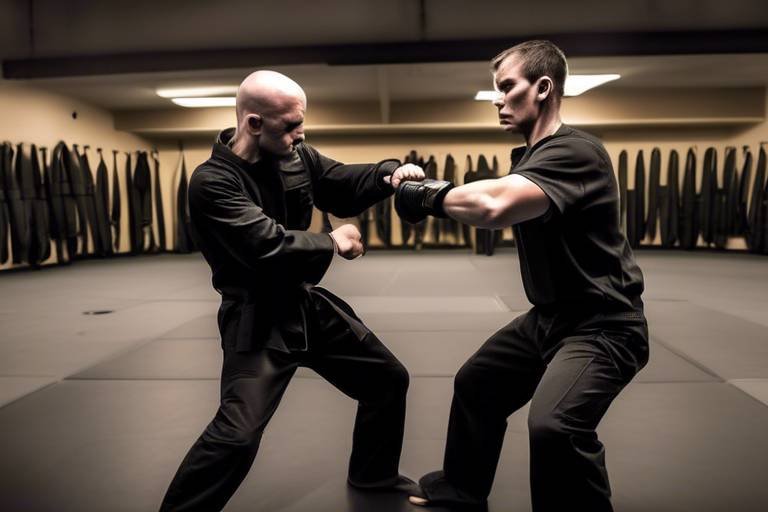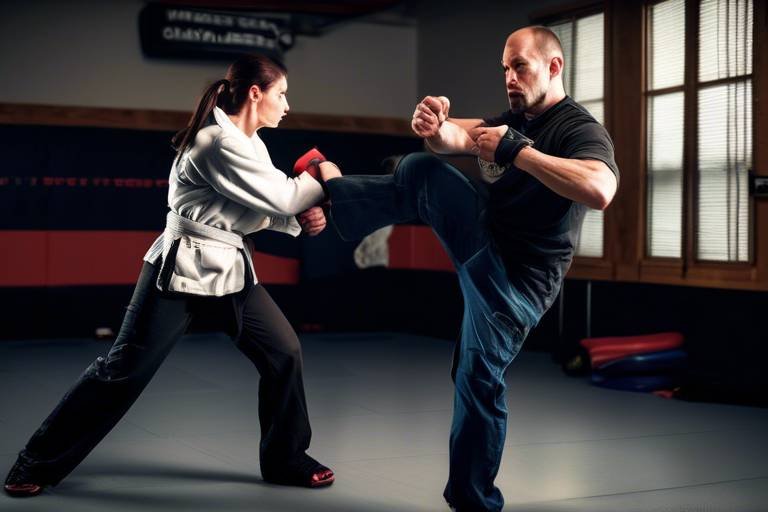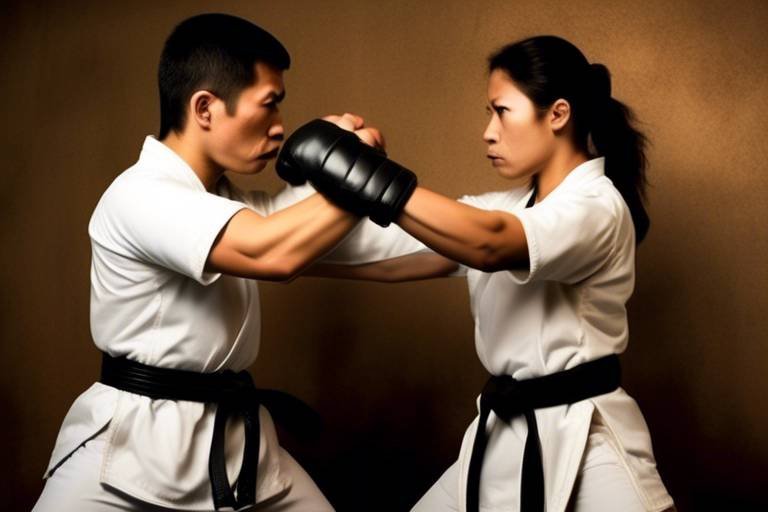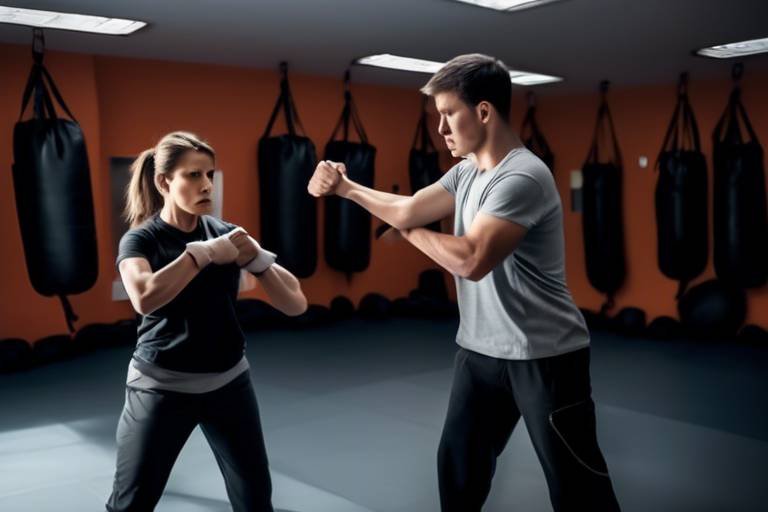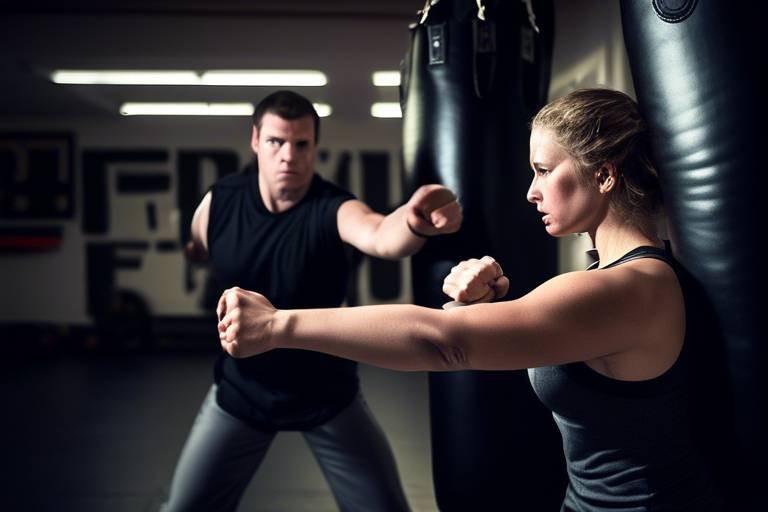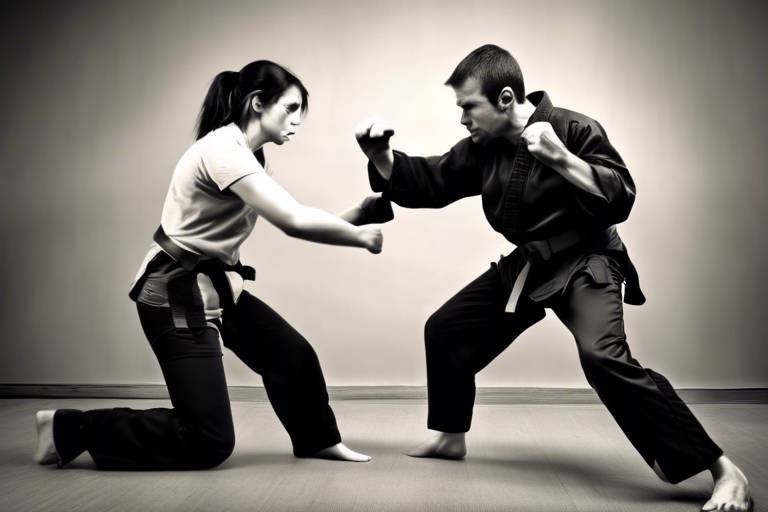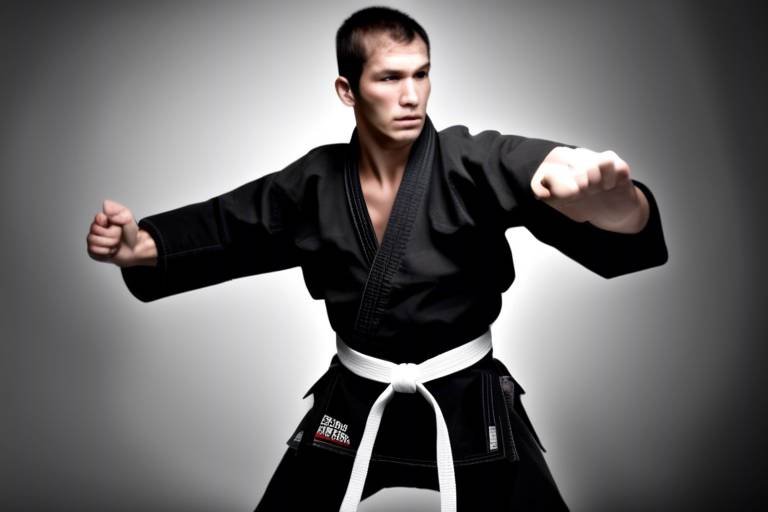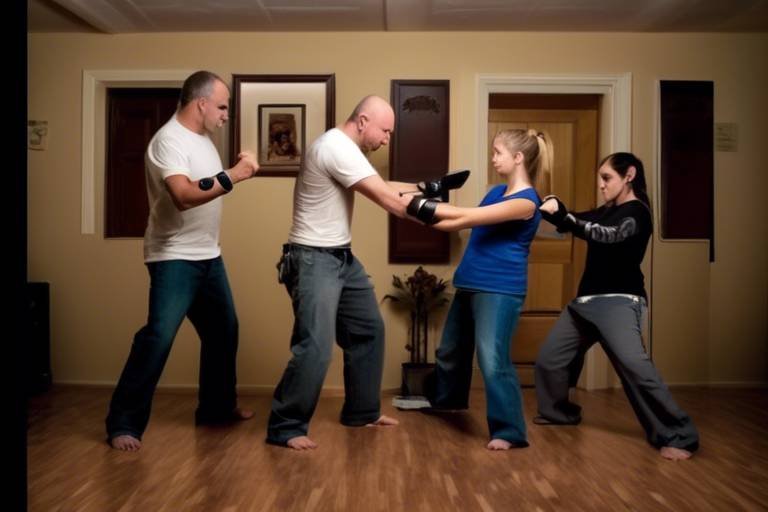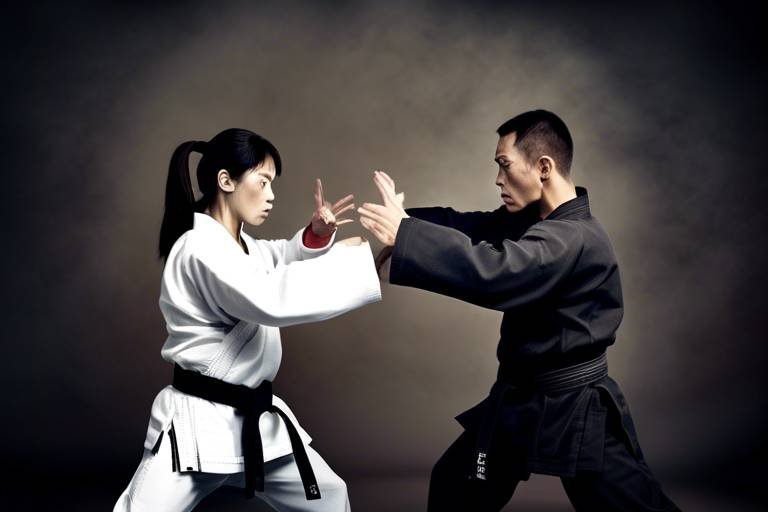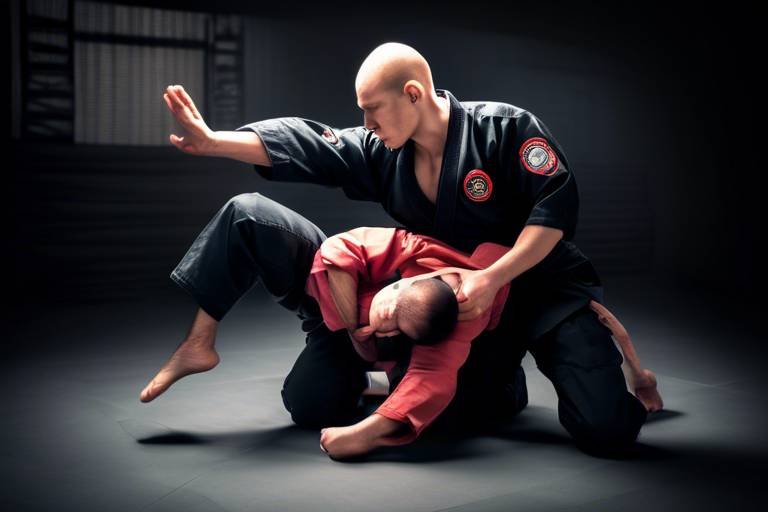Self-Defense Techniques Everyone Should Learn
Self-defense is not just a skill; it’s a vital life lesson that everyone should embrace. Imagine walking down the street, feeling confident and aware of your surroundings, knowing that you have the tools to protect yourself if the need arises. This article explores essential self-defense techniques that empower individuals to protect themselves in various situations, emphasizing the importance of awareness, physical skills, and mental preparedness. Whether you’re a teenager, an adult, or even a senior citizen, understanding self-defense can be a game-changer in your life.
Self-defense is crucial for personal safety, and it goes beyond just physical techniques. It encompasses a mindset that helps you navigate through potentially dangerous situations. Learning self-defense techniques is not just for those who feel threatened; it’s for everyone. Here are a few reasons why:
- Empowerment: Knowing how to defend yourself boosts your confidence and sense of security.
- Awareness: Self-defense training teaches you to be more aware of your surroundings, which can help you avoid dangerous situations altogether.
- Physical Fitness: Many self-defense techniques involve physical activity, which promotes a healthier lifestyle.
Regardless of age, gender, or physical ability, self-defense techniques can be adapted to suit anyone. It’s about being prepared and having the knowledge to react appropriately when faced with a threat.
Let’s dive into some fundamental self-defense techniques that are easy to learn and can be effective in real-life situations. These moves provide a solid foundation for anyone looking to improve their self-defense skills. The best part? You don’t need to be a martial arts expert to execute them effectively.
Strikes and kicks are essential components of self-defense. They can create the necessary distance between you and an attacker, giving you a chance to escape. Here are some effective striking techniques:
- Punches: A well-aimed punch to the nose or jaw can disorient an attacker.
- Elbow Strikes: These are powerful and can be delivered at close range.
- Knees: A knee strike to the groin can incapacitate an assailant quickly.
But it’s not just about throwing punches; it’s about knowing how to deliver powerful kicks as well. A well-placed kick to the knee or shin can deter an attacker effectively.
Understanding where to strike is crucial. The human body has several vulnerable areas that can maximize the effectiveness of your self-defense moves. Targeting these areas can increase your chances of escaping an attack:
| Vulnerable Area | Effect |
|---|---|
| Eyes | Temporary blindness and disorientation |
| Throat | Difficulty breathing, causing panic |
| Groin | Intense pain, incapacitation |
By focusing on these areas, you can create a window of opportunity to escape from a dangerous situation.
Leveraging your body weight can significantly enhance your striking power. Techniques like hip throws or body weight shifts can help you gain an advantage over a larger attacker. Think of it like using a pendulum; the more you swing your weight, the more force you generate. It’s all about using your body effectively to maximize your impact.
Defensive maneuvers are key in avoiding confrontation altogether. Knowing how to block, dodge, and evade attacks can minimize harm and give you the upper hand. For instance, a simple block can redirect an incoming strike, while a quick dodge can put you out of harm's way. It's like dancing; the more fluid you are in your movements, the better you can adapt to the rhythm of the situation.
Situational awareness is fundamental to self-defense. It’s about being conscious of your environment and recognizing potential threats before they escalate. This skill can be developed through practice and mindfulness.
Being able to identify potential threats is vital. Look for signs of danger, such as:
- Unusual behavior from individuals around you
- Being followed or watched
- Changes in the environment, like sudden silence
By assessing situations and trusting your instincts, you can enhance your personal safety and avoid dangerous encounters.
Your instincts can be your best defense. If something feels off, it probably is. Trusting your gut feelings can help you steer clear of risky situations. It’s akin to having an internal alarm system that alerts you when danger is near.
While physical techniques are essential, having tools can provide added protection. Various self-defense tools are available, and understanding their uses can enhance your safety.
Personal alarms are effective deterrents. These small devices emit a loud sound when activated, drawing attention to your situation. They can be a lifesaver in emergencies, alerting others to your distress.
Pepper spray can incapacitate an attacker temporarily. It’s crucial to understand its proper use, legal considerations, and tips for effective deployment. Remember, it’s not just about having the tool; it’s about knowing how to use it responsibly.
Q: Do I need to be physically fit to learn self-defense?
A: No, self-defense techniques can be adapted to suit all fitness levels. It's more about technique and awareness than brute strength.
Q: Can self-defense training help me avoid dangerous situations?
A: Absolutely! Self-defense training emphasizes situational awareness, which can help you identify and avoid potential threats.
Q: Are self-defense tools legal to carry?
A: This varies by location. It's essential to check local laws regarding the possession and use of self-defense tools like pepper spray.

Understanding the Importance of Self-Defense
Self-defense is not just a skill; it’s a vital part of personal safety that everyone should take seriously. Imagine walking down the street, feeling confident and secure, knowing you have the means to protect yourself if the need arises. In today's unpredictable world, understanding self-defense techniques can be the difference between safety and vulnerability. It’s essential for individuals of all ages, genders, and physical abilities to acquire these skills. After all, being prepared is a form of empowerment.
One of the primary reasons to learn self-defense is the rising concern about personal safety. Reports of assaults and attacks are prevalent, and the reality is that anyone can become a potential target. By learning self-defense, you not only enhance your ability to protect yourself but also boost your confidence. Imagine the feeling of walking into a room and knowing you can handle yourself if things go south. This confidence can be a powerful deterrent against potential attackers.
Moreover, self-defense training teaches you about awareness and prevention. It’s not just about physical techniques but also about understanding your environment. Learning to recognize potentially dangerous situations can often help you avoid them altogether. For instance, being aware of people around you, noticing unusual behavior, or recognizing unsafe areas can significantly reduce your risk of becoming a victim. This aspect of self-defense is crucial; it’s about being proactive rather than reactive.
In addition to awareness, self-defense training can foster mental preparedness. When you know how to respond to a threat, you are less likely to panic in a stressful situation. Think of it as a mental rehearsal: the more you practice, the more instinctive your reactions become. This mental readiness can make a significant difference when faced with an unexpected encounter. It’s about training your mind to stay calm and focused, allowing you to make quick decisions under pressure.
Furthermore, self-defense is not solely about physical confrontation. It encompasses a range of skills, including verbal de-escalation techniques. Sometimes, the best way to handle a situation is to defuse it with words rather than fists. Learning how to communicate effectively in tense situations can prevent conflicts from escalating into violence. This holistic approach to self-defense is what makes it essential for everyone.
In conclusion, understanding the importance of self-defense goes beyond just learning how to throw a punch or kick. It’s about empowerment, awareness, and mental preparedness. By equipping yourself with these skills, you not only enhance your personal safety but also contribute to a more secure environment for those around you. Remember, self-defense is a lifelong journey of learning and awareness, and it’s never too late to start.

Basic Self-Defense Moves
When it comes to self-defense, mastering some basic moves can make all the difference in a dangerous situation. You might think that self-defense requires years of training or advanced martial arts skills, but that's simply not true. In fact, there are several fundamental techniques that anyone can learn, regardless of their age or physical ability. These moves are designed to be effective in real-life scenarios, allowing you to protect yourself when it matters most.
First off, let's talk about strikes and kicks. Striking techniques, such as punches and elbow strikes, are essential for creating distance between you and an attacker. A well-placed punch to the nose or a swift elbow to the jaw can stun an assailant and give you the chance to escape. Similarly, kicks can be incredibly powerful tools in self-defense. Think about your legs as natural weapons! A strong kick to the knee or groin can incapacitate an attacker, allowing you to flee to safety.
To effectively deliver strikes and kicks, it's important to practice proper form and technique. Start with a few basic strikes:
- Jab: A quick, straight punch that can be used to keep an attacker at bay.
- Cross: A powerful punch that follows the jab, aimed at the attacker's face.
- Roundhouse Kick: A circular kick that targets the head or body, delivering significant force.
These moves can be practiced in front of a mirror or with a friend to build confidence. Remember, the goal is not to engage in a fight, but to create an opportunity to escape. Always aim for vulnerable areas of the body, which brings us to the next important point.
Understanding where to strike is crucial for maximizing your self-defense effectiveness. Some of the most vulnerable areas on an attacker’s body include:
- Eyes: A quick jab or poke can temporarily blind an assailant.
- Nose: A solid punch can cause pain and disorientation.
- Throat: A strike here can incapacitate an attacker momentarily.
- Groin: Kicking or striking this area can cause immediate pain and allow you to escape.
By focusing on these areas, you increase your chances of successfully defending yourself and getting away from a dangerous situation.
Another essential aspect of effective self-defense is learning how to leverage your body weight. This means using your entire body to add power to your strikes and kicks. For example, when throwing a punch, rotate your hips and shoulders to generate more force. Similarly, when delivering a kick, shift your weight onto your standing leg to propel your kicking leg forward with greater strength. This technique not only increases the impact of your strikes but also helps maintain your balance, making you less likely to be knocked off your feet.
In addition to offensive moves, defensive maneuvers are vital for avoiding confrontation altogether. Techniques like blocking, dodging, and evading attacks can help you minimize harm and create opportunities to escape. Practicing these defensive moves can prepare you for unexpected situations, allowing you to respond swiftly and effectively.
In summary, learning these basic self-defense moves can empower you to protect yourself in various situations. The key is to practice regularly and stay aware of your surroundings. Remember, the best defense is often to avoid confrontation whenever possible. However, if you find yourself in a dangerous situation, these fundamental techniques can make all the difference.

Strikes and Kicks
When it comes to self-defense, mastering is essential. These techniques are not just about brute strength; they require precision, timing, and a bit of finesse. Imagine being in a situation where you need to protect yourself. You want to be able to deliver a powerful blow or a swift kick that can create an opportunity for you to escape. The beauty of strikes and kicks lies in their simplicity and effectiveness. They can be learned quickly and practiced regularly, allowing anyone, regardless of their physical ability, to feel empowered.
Strikes can be categorized into different types, such as punches, elbows, and knee strikes. Each of these has its own unique advantages. For instance, a well-placed punch can catch an attacker off guard, while an elbow strike can be devastating in close quarters. Kicks, on the other hand, can be used to maintain distance or target vulnerable areas of an assailant’s body. The power of a kick comes from the legs, which are typically stronger than the arms. This makes kicks particularly effective when executed correctly.
Here are a few essential strikes and kicks every individual should consider learning:
- Jab: A quick, straight punch that can create space.
- Cross: A powerful punch that follows the jab, aimed at the opponent’s face or body.
- Front Kick: A straightforward kick that targets the groin or stomach.
- Roundhouse Kick: A kick that strikes with the instep or shin, targeting the head or body.
- Knee Strike: An effective close-range attack aimed at the attacker’s midsection.
One of the most critical aspects of delivering effective strikes and kicks is targeting vulnerable areas. Understanding where to strike can significantly enhance your chances of successfully defending yourself. Vulnerable areas include:
| Vulnerable Area | Effectiveness |
|---|---|
| Eyes | Causes temporary blindness, allowing for escape. |
| Throat | Can incapacitate an attacker if struck correctly. |
| Groin | Can cause immense pain and distraction. |
| Knees | Targeting the knee can destabilize an attacker. |
Another important factor is using your body weight effectively. When you strike or kick, it’s not just about the strength in your arms or legs; it’s about how you can transfer your body weight into the movement. For example, when delivering a punch, pivoting your feet and rotating your hips can add significant power to your strike. Similarly, when executing a kick, using your body’s momentum can increase the impact of your kick, making it more effective at deterring an attacker.
In conclusion, mastering strikes and kicks is a fundamental aspect of self-defense. It’s not just about throwing punches or kicks; it’s about understanding how to use your body effectively and targeting your opponent’s vulnerable areas. With practice and awareness, these skills can empower you to defend yourself and escape dangerous situations.
Q: Do I need to be physically fit to learn self-defense techniques?
A: No, self-defense techniques can be adapted to fit any fitness level. With practice, anyone can learn effective self-defense moves.
Q: How long does it take to learn basic self-defense techniques?
A: Many people can learn basic techniques in just a few classes. Consistent practice will improve your skills significantly.
Q: Are there any legal considerations I should be aware of regarding self-defense?
A: Yes, laws regarding self-defense vary by location. It's important to understand the laws in your area to ensure you act within your rights.
Q: Can self-defense training help with confidence?
A: Absolutely! Many individuals report increased confidence and awareness after participating in self-defense training.

Targeting Vulnerable Areas
When it comes to self-defense, understanding where to strike can make all the difference. It's not just about throwing a punch or a kick; it's about maximizing the impact of your actions. By targeting vulnerable areas on an assailant's body, you can increase your chances of escaping a dangerous situation. Think of it like playing a game of chess—knowing your opponent's weaknesses allows you to make strategic moves that can turn the tide in your favor.
Vulnerable areas are essentially spots on the body that are more susceptible to pain and injury. These areas include:
- Eyes: A swift jab or poke can temporarily blind or distract an attacker.
- Nose: A well-placed strike can cause pain and disorientation.
- Throat: A quick strike can incapacitate an assailant.
- Solar Plexus: A hit here can knock the wind out of someone, giving you a chance to escape.
- Knees: A kick to the knee can destabilize an attacker, making it harder for them to pursue you.
By focusing your efforts on these areas, you can create an opportunity to escape without needing to engage in a prolonged confrontation. Remember, the goal is not to win a fight but to protect yourself and get to safety. It's essential to practice these techniques under the guidance of a trained instructor so that you can execute them effectively when the time comes.
Moreover, leveraging your body weight while targeting these vulnerable areas can amplify your effectiveness. For instance, if you're delivering a knee strike to an attacker's thigh, using your body weight to drive the strike can increase its impact. This is similar to how a small car can cause significant damage if it hits a stationary object at high speed. In self-defense, you want to be that small car, using your momentum and technique to achieve a powerful effect.
In conclusion, knowing how to target vulnerable areas is a crucial component of self-defense. It empowers you to make quick, decisive actions that can help you escape dangerous situations. Always keep in mind that self-defense is about survival, and understanding these principles can make all the difference when it matters most.
Q: What are the most effective vulnerable areas to target in self-defense?
A: The most effective vulnerable areas include the eyes, nose, throat, solar plexus, and knees. Striking these areas can incapacitate an attacker and provide you with a chance to escape.
Q: How can I practice targeting these areas safely?
A: It's best to practice under the supervision of a trained instructor in a controlled environment. They can provide guidance on technique and ensure safety during practice.
Q: Is it legal to use self-defense techniques?
A: Yes, self-defense is legal, but the laws vary by location. It's important to understand your local laws regarding self-defense and the use of force.

Using Your Body Weight
When it comes to self-defense, one of the most powerful tools at your disposal is your own body weight. You might be thinking, "How can I leverage my weight in a situation where I'm being attacked?" Well, it's all about understanding the mechanics of your body and how to use it to your advantage. Just like a well-placed punch can send an opponent reeling, using your body weight effectively can amplify your strikes and create more impact.
Imagine you're trying to push a heavy object. It's not just about how strong your arms are; it's also about using your legs and core to generate power. The same principle applies in self-defense. When you strike, you want to engage your entire body, not just your arms. By shifting your weight and utilizing your legs, you can deliver a more powerful blow. For instance, when throwing a punch, pivot on your back foot and transfer your weight forward. This movement not only increases the force of your strike but also helps maintain your balance.
Another effective technique is using your body weight to control an opponent. If you find yourself in a grappling situation, you can use your weight to your advantage by applying pressure. For example, if you're in a standing position and your assailant is trying to grab you, you can lower your center of gravity and use your hips to push them away. This not only creates distance but also gives you the opportunity to escape or counterattack.
Here are a few tips for effectively using your body weight in self-defense:
- Shift Your Weight: Always be aware of your center of gravity. Shift your weight to your dominant foot when preparing to strike.
- Engage Your Core: A strong core stabilizes your body and enhances your striking power.
- Stay Relaxed: Tension can slow you down. Stay loose to react quickly and efficiently.
Incorporating these techniques into your self-defense training can significantly increase your effectiveness in real-life situations. Remember, it’s not just about size or strength; it’s about technique and strategy. By mastering the art of using your body weight, you’ll be better prepared to defend yourself and potentially turn the tables on an attacker.
Q: Can anyone learn to use their body weight effectively in self-defense?
A: Absolutely! With practice and proper technique, anyone can learn to use their body weight to enhance their self-defense skills.
Q: Do I need to be strong to use my body weight in self-defense?
A: Not at all. Self-defense is more about technique and timing than brute strength. Understanding body mechanics is key.
Q: How can I practice these techniques safely?
A: It's best to practice under the guidance of a trained instructor or in a controlled environment where you can safely learn and refine your skills.

Defensive Maneuvers
When it comes to self-defense, mastering is just as crucial as knowing how to strike. Think of defensive techniques as your first line of defense; they help you avoid confrontation and minimize harm. The goal here is to create space and time to escape rather than engage directly with an attacker. After all, isn’t it better to prevent a fight than to win one?
One of the most effective defensive techniques is blocking. This involves using your arms or hands to deflect an incoming strike. Imagine it like a shield protecting you from arrows in a medieval battle. The key is to keep your body relaxed and your eyes focused on the attacker. A stiff body will only make you more vulnerable to injury. When executed correctly, blocking can not only protect you but also open up opportunities for counterattacks.
Another essential maneuver is dodging. This technique is all about movement. Instead of standing still and waiting for an attack, you can shift your body to avoid incoming blows. Picture a matador gracefully sidestepping a charging bull; that’s the kind of agility you want to develop. Practice moving your head and torso away from the line of attack while keeping your feet ready to spring into action. The more fluid your movements, the harder it becomes for an attacker to land a hit.
Additionally, evading is another critical aspect of defensive maneuvers. This technique involves not just dodging but also repositioning yourself to create distance from the attacker. For instance, if someone lunges at you, stepping to the side or backward can create the necessary space to escape. It’s like playing a game of chess; you need to anticipate your opponent's moves and react swiftly. The more you practice these maneuvers, the more instinctive they will become.
To further illustrate the importance of defensive maneuvers, let’s consider a scenario. Imagine you’re walking home at night and someone approaches you aggressively. Instead of panicking, you can employ a combination of blocking and dodging to protect yourself. By keeping your guard up and staying aware of your surroundings, you can effectively maneuver your way out of a dangerous situation. Remember, the ultimate goal is to escape safely, not to engage in a fight.
In summary, mastering defensive maneuvers is a vital part of self-defense training. By focusing on techniques such as blocking, dodging, and evading, you can enhance your ability to protect yourself in various situations. Practice these skills regularly, and you will find that your confidence and awareness will grow, making you feel more empowered in your daily life.
- What are defensive maneuvers? Defensive maneuvers are techniques used to avoid or minimize harm during an attack, focusing on movement and positioning rather than direct confrontation.
- Why are defensive maneuvers important? They help you create space and time to escape dangerous situations, reducing the likelihood of injury.
- Can anyone learn defensive maneuvers? Yes, defensive maneuvers can be learned by anyone, regardless of age or physical ability, through practice and training.
- How can I practice defensive maneuvers? You can practice these techniques through drills, sparring with a partner, or attending self-defense classes.

Situational Awareness
Situational awareness is not just a fancy term thrown around in self-defense classes; it’s a vital skill that can be the difference between safety and danger. Imagine walking down a busy street, your mind wandering to what you’ll have for dinner or the latest Netflix series you’ve been binge-watching. Suddenly, you notice a group of individuals loitering, their demeanor suspicious. This is where situational awareness kicks in. It’s about being present and alert, tuning into your surroundings, and recognizing when something feels off. When you cultivate this awareness, you create a buffer against potential threats, allowing you to react swiftly and appropriately.
Think of situational awareness as a sixth sense. It’s like having a radar that picks up on subtle cues in your environment. This skill involves not only seeing what's in front of you but also interpreting the behavior of people around you. Are they acting unusually? Is there something about their body language that raises a red flag? By honing your ability to recognize these signs, you empower yourself to make informed decisions that can keep you safe.
To enhance your situational awareness, consider the following strategies:
- Stay Engaged: Avoid distractions like your phone or headphones when you’re out and about. Being fully present allows you to notice details that could indicate a threat.
- Observe Your Environment: Take a moment to scan your surroundings. Identify exits, potential hiding spots, and the people around you. This mental mapping can be invaluable in a crisis.
- Trust Your Gut: If something feels off, it probably is. Your instincts are honed by experience, so don’t dismiss them.
Situational awareness also involves understanding the dynamics of different environments. For instance, a crowded subway station may present different challenges than a quiet park. In bustling areas, you might need to be more alert to pickpockets, while in isolated spaces, the focus might shift to personal safety from physical threats. By adapting your awareness to the context, you can better prepare yourself for various situations.
Moreover, practicing situational awareness isn’t just about being vigilant; it’s also about developing a proactive mindset. This means thinking ahead and considering potential scenarios. For instance, if you’re heading to a new location, take some time to research the area. Are there reports of crime? What’s the general vibe of the neighborhood? This information can help you make informed choices about when and where to travel.
In summary, situational awareness is a powerful tool in the realm of self-defense. It equips you with the ability to perceive, interpret, and respond to your environment effectively. By integrating these practices into your daily life, you not only enhance your safety but also cultivate a sense of confidence that comes from being in control of your surroundings.
| Question | Answer |
|---|---|
| What is situational awareness? | Situational awareness is the ability to be aware of your surroundings and recognize potential threats in order to respond appropriately. |
| How can I improve my situational awareness? | You can improve your situational awareness by staying engaged, observing your environment, and trusting your instincts. |
| Why is situational awareness important for self-defense? | It allows you to identify potential dangers before they escalate, giving you the opportunity to avoid or mitigate threats. |

Recognizing Threats
Recognizing potential threats is a crucial skill that can significantly enhance your personal safety. Imagine walking down a quiet street and suddenly feeling a sense of unease; that feeling is your instinct kicking in, urging you to pay attention. Being able to identify signs of danger before they escalate can make all the difference in ensuring your safety. It's not just about being paranoid; it's about being aware. Awareness is your first line of defense.
So, what should you be looking for? There are several telltale signs that can indicate a potential threat. For instance, if someone is acting unusually—like loitering in an area without purpose or watching you too intently—this could be a red flag. Additionally, consider the environment around you. Are there too many dark corners or places where someone could hide? These factors can contribute to your overall sense of safety.
Here are some common indicators that might signal a threat:
- Body Language: Pay attention to how people carry themselves. Aggressive postures or sudden movements can indicate hostility.
- Unusual Behavior: If someone is behaving erratically or seems out of place, it’s worth taking notice.
- Group Dynamics: Be cautious of groups that seem to be targeting individuals or acting in a coordinated manner.
In addition to these signs, it’s essential to trust your instincts. Your gut feeling can often sense danger before your mind can process it. If something feels off, it probably is. This instinctual alertness can serve as an early warning system, allowing you to take precautionary measures before a situation escalates. Remember, your safety is paramount, and being aware of your surroundings is a powerful tool in self-defense.
Moreover, consider practicing situational awareness regularly. This can be as simple as making a habit of scanning your environment when you enter a new space or being mindful of who is around you when you're out and about. With time, recognizing potential threats will become second nature, allowing you to navigate the world more confidently and safely.
In conclusion, recognizing threats is not just about knowing what to look for; it’s about developing a mindset that prioritizes safety. By staying aware and trusting your instincts, you empower yourself to act decisively in the face of danger, turning fear into confidence. Always remember, being prepared is half the battle.
Q: What should I do if I feel threatened?
A: If you feel threatened, trust your instincts and remove yourself from the situation as quickly as possible. If necessary, seek help from authorities or bystanders.
Q: How can I improve my situational awareness?
A: Practice being mindful of your surroundings. Regularly scan your environment, notice the people around you, and assess any potential threats.
Q: Are there specific signs to look for in a threatening person?
A: Yes, look for aggressive body language, unusual behavior, and groups that seem to be targeting individuals. Trust your gut feelings as well.

Trusting Your Instincts
When it comes to personal safety, trusting your instincts can be a game changer. Have you ever felt that little twinge in your gut telling you something isn't right? That feeling is your body's natural alarm system, honed through evolution to help you navigate potentially dangerous situations. Ignoring these instincts can often lead to regrettable outcomes, while listening to them can empower you to take action before a situation escalates.
Imagine walking down a quiet street and suddenly feeling uneasy. Your heart races, and you can't quite put your finger on why. This is precisely the moment to tune into that internal voice. It might be your subconscious picking up on subtle cues that your conscious mind hasn't fully processed yet. Whether it's an unusual behavior from someone nearby or simply an odd vibe in the air, these feelings are often based on your past experiences and observations.
But how do you differentiate between a genuine instinct and just a fleeting fear? Here are a few tips to help you trust your instincts effectively:
- Stay Calm: Panic can cloud your judgment. Take a deep breath and assess the situation.
- Reflect on Past Experiences: Think about similar situations you've encountered and how they turned out. Did your instincts guide you well before?
- Listen to Your Body: Physical signs like sweating, increased heart rate, or a feeling of dread can be indicators that you should pay attention to your instincts.
It’s essential to cultivate a habit of recognizing and acting on these instincts. The more you practice this, the sharper your intuition will become. For instance, if you notice someone following you, don’t dismiss that feeling as paranoia. Instead, consider your options—cross the street, enter a store, or call a friend. Taking proactive steps can often deter a potential threat.
Moreover, trusting your instincts isn't just about reacting to immediate danger; it's also about prevention. Being aware of your surroundings and recognizing when something feels off can help you avoid risky situations altogether. For example, if you're in a crowded place and feel uncomfortable, it might be a good idea to move to a more populated area or find a security personnel to talk to.
In summary, your instincts can be one of your most powerful allies in self-defense. They are a blend of your experiences, knowledge, and innate ability to perceive danger. By learning to trust and act on them, you can enhance your personal safety and navigate the world with greater confidence.
- What should I do if I feel unsafe in a situation? Trust your instincts. If something feels off, remove yourself from the situation as quickly and safely as possible.
- How can I improve my situational awareness? Practice being observant in your daily life. Notice details around you, such as people’s behaviors and the environment. This can help sharpen your instincts.
- Are there specific techniques to enhance my intuition? Yes! Mindfulness exercises, such as meditation, can help you become more attuned to your feelings and instincts.

Self-Defense Tools and Weapons
While mastering physical self-defense techniques is vital, incorporating into your personal safety strategy can significantly enhance your ability to protect yourself. These tools are not just about having an item on hand; they are about empowering you to feel more secure and prepared in various situations. Imagine walking down a dimly lit street, and instead of feeling anxious, you have a personal alarm or pepper spray ready to use. This sense of readiness can make all the difference in your confidence and overall safety.
When considering self-defense tools, it’s crucial to choose ones that you feel comfortable using and that comply with local laws. Here are some of the most popular self-defense tools that can help you in a pinch:
- Personal Alarms: These small devices emit a loud noise when activated, drawing attention to your situation. They are easy to carry and can be a great deterrent against potential attackers.
- Pepper Spray: This is a popular self-defense tool that can incapacitate an attacker temporarily. It’s essential to understand how to use it effectively and be aware of the legal implications of carrying it.
- Self-Defense Keychains: Some keychains are designed specifically for self-defense, featuring pointed edges or other mechanisms that can be used in an emergency.
Each of these tools has its own advantages and considerations. For instance, personal alarms are excellent for alerting others but may not physically deter an attacker. On the other hand, pepper spray can incapacitate an assailant, but it requires a bit of practice to use effectively. Understanding the pros and cons of each tool can help you make an informed decision about what to carry.
It's important to note that self-defense tools should not replace physical self-defense skills but rather complement them. For example, if you find yourself in an uncomfortable situation, knowing how to use pepper spray effectively can buy you valuable seconds to escape. However, if the situation escalates beyond what a tool can handle, your physical skills will be crucial. Therefore, a well-rounded approach that incorporates both physical techniques and self-defense tools is the most effective strategy for personal safety.
Moreover, always remember to practice using your self-defense tools. Just like any skill, familiarity breeds confidence. Consider enrolling in self-defense classes that also cover the use of these tools. This hands-on experience will prepare you for real-life situations, making you feel more empowered and less vulnerable.
When carrying self-defense tools, safety is paramount. Always ensure that you are aware of the laws regarding self-defense tools in your area. Some places have restrictions on carrying certain items, and being unaware of these laws could lead to legal complications. Additionally, consider how accessible your tools are; they should be easy to reach in an emergency but also secured to prevent accidental activation.
In summary, self-defense tools and weapons can be valuable assets in your personal safety arsenal. They enhance your ability to protect yourself and can provide peace of mind in various situations. By combining these tools with physical self-defense techniques and maintaining a strong sense of situational awareness, you can significantly increase your safety and confidence in any environment.
Q: Are self-defense tools legal to carry?
A: The legality of carrying self-defense tools varies by location. Always check local laws to ensure compliance.
Q: How do I choose the right self-defense tool for me?
A: Consider your comfort level, the situations you may encounter, and the legal implications of carrying specific tools.
Q: Can self-defense tools replace physical self-defense training?
A: No, self-defense tools should complement physical skills, not replace them. It's essential to be trained in both areas for maximum effectiveness.

Personal Alarms
Personal alarms are a fantastic tool for enhancing your safety and providing an extra layer of protection in potentially dangerous situations. These small, portable devices emit a loud sound when activated, drawing attention to you and potentially scaring off an attacker. Imagine walking alone at night and suddenly feeling uneasy; having a personal alarm at your fingertips can be a game-changer. The sound produced can reach up to 130 decibels, which is comparable to a jet engine at takeoff! This loud noise not only alerts those nearby but can also create a sense of panic in an assailant, giving you the chance to escape.
Using a personal alarm is straightforward. Most models come with a simple pull pin or a button that you can easily activate. It's important to practice using your alarm so that you can react quickly in an emergency. Additionally, many personal alarms are compact and lightweight, making them easy to carry in your bag, pocket, or even on your keychain. This convenience means you can have it with you at all times, ready to use when you need it most.
When considering a personal alarm, there are a few factors to keep in mind:
- Volume: Look for alarms that can produce a sound loud enough to attract attention from a distance.
- Battery Life: Ensure the alarm has a long-lasting battery or is rechargeable.
- Design: Choose a model that is easy to carry and activate, preferably one that fits comfortably in your hand.
Moreover, personal alarms can serve multiple purposes beyond self-defense. They can also be used in emergencies, such as alerting someone if you fall or need assistance. Many alarms come with additional features, like built-in flashlights or even GPS tracking, which can further enhance your safety. By integrating a personal alarm into your self-defense toolkit, you are not only arming yourself with a physical deterrent but also empowering yourself to take control of your personal safety.
Q: How effective are personal alarms in deterring attackers?
A: Personal alarms can be highly effective as they create a loud noise that can startle an attacker and attract attention from passersby. The unexpected sound can disrupt the attacker's focus, giving you a chance to escape.
Q: Are personal alarms legal to carry?
A: Yes, personal alarms are generally legal to carry in most places. However, it's essential to check local laws and regulations to ensure compliance.
Q: How do I maintain my personal alarm?
A: Regularly check the battery and functionality of your personal alarm. If it is rechargeable, make sure to charge it as needed. It's also a good idea to test the sound periodically to ensure it's working correctly.

Pepper Spray
Pepper spray is a popular self-defense tool that can provide a significant advantage in dangerous situations. It’s compact, easy to carry, and can be a lifesaver when used correctly. Imagine walking down a dimly lit street and suddenly feeling threatened. In that moment, having pepper spray can give you the confidence to protect yourself without needing to engage physically. But how does it work, and what should you know before carrying it?
Pepper spray contains capsaicin, the active ingredient derived from hot peppers, which causes a burning sensation in the eyes, skin, and respiratory system of an attacker. When sprayed, it can incapacitate an assailant for several minutes, giving you the opportunity to escape. However, it’s crucial to understand both the advantages and limitations of this tool. For instance, wind direction can affect its effectiveness, and it may not work as well against individuals under the influence of drugs or alcohol.
Before you decide to carry pepper spray, consider these important factors:
- Legal Regulations: Laws regarding the possession and use of pepper spray vary by location. Be sure to research your local laws to ensure you’re compliant.
- Type of Spray: There are different formulations of pepper spray, including varying concentrations and spray patterns. Choose one that suits your needs.
- Training: Familiarize yourself with how to use the spray effectively. Practice aiming and deploying it in a safe environment to build confidence.
In addition to understanding how to use pepper spray, it’s essential to consider where to keep it. A keychain model might be convenient, but make sure it’s easily accessible. You never want to fumble with your self-defense tool during a critical moment. Also, remember to check the expiration date regularly; the effectiveness of pepper spray can diminish over time.
Finally, while pepper spray is an effective self-defense tool, it should be part of a broader personal safety strategy. Combine it with self-defense training, situational awareness, and a strong intuition about your surroundings. By doing so, you’ll enhance your ability to protect yourself and stay safe in various situations.
| Question | Answer |
|---|---|
| Is pepper spray legal to carry? | It depends on your location; always check local laws before carrying pepper spray. |
| How effective is pepper spray? | Pepper spray can incapacitate an attacker for several minutes, but effectiveness can vary based on several factors. |
| Can pepper spray be used on multiple attackers? | While it can affect multiple attackers, it is most effective when aimed at a single target. |
| What should I do if I accidentally spray myself? | Move to a well-ventilated area, flush your eyes with water, and seek medical attention if necessary. |
Frequently Asked Questions
- Why should I learn self-defense?
Learning self-defense is essential for personal safety. It empowers you to protect yourself in dangerous situations, boosts your confidence, and enhances your awareness of your surroundings. Plus, it’s a great way to stay physically active!
- What are some basic self-defense moves I can learn?
Some fundamental self-defense moves include simple strikes, kicks, and defensive maneuvers like blocking and dodging. These techniques are easy to grasp and can be effective in real-life scenarios, giving you a solid foundation to build upon.
- How can I effectively target vulnerable areas during an attack?
Targeting vulnerable areas, such as the eyes, nose, throat, and groin, can maximize the effectiveness of your self-defense techniques. Striking these areas can cause significant pain and give you the opportunity to escape.
- What role does situational awareness play in self-defense?
Situational awareness is crucial for anticipating potential threats before they escalate. By being aware of your surroundings and recognizing signs of danger, you can take proactive measures to protect yourself and avoid risky situations.
- What self-defense tools should I consider carrying?
Some effective self-defense tools include personal alarms and pepper spray. Personal alarms can draw attention and deter attackers, while pepper spray can incapacitate an assailant, giving you a chance to escape.
- Are there legal considerations for using self-defense tools like pepper spray?
Yes, it’s important to understand the legal regulations regarding self-defense tools in your area. Laws vary by location, so always check local laws to ensure you are compliant and know how to use these tools responsibly.
- Can self-defense training help improve my physical fitness?
Absolutely! Self-defense training not only teaches you valuable skills but also provides a great workout. It helps improve your strength, flexibility, and overall fitness while boosting your confidence and mental resilience.
- How can I find a good self-defense class?
Look for local martial arts studios, community centers, or fitness gyms that offer self-defense classes. Check reviews, ask for recommendations, and consider trying a few classes to find the right fit for you!

